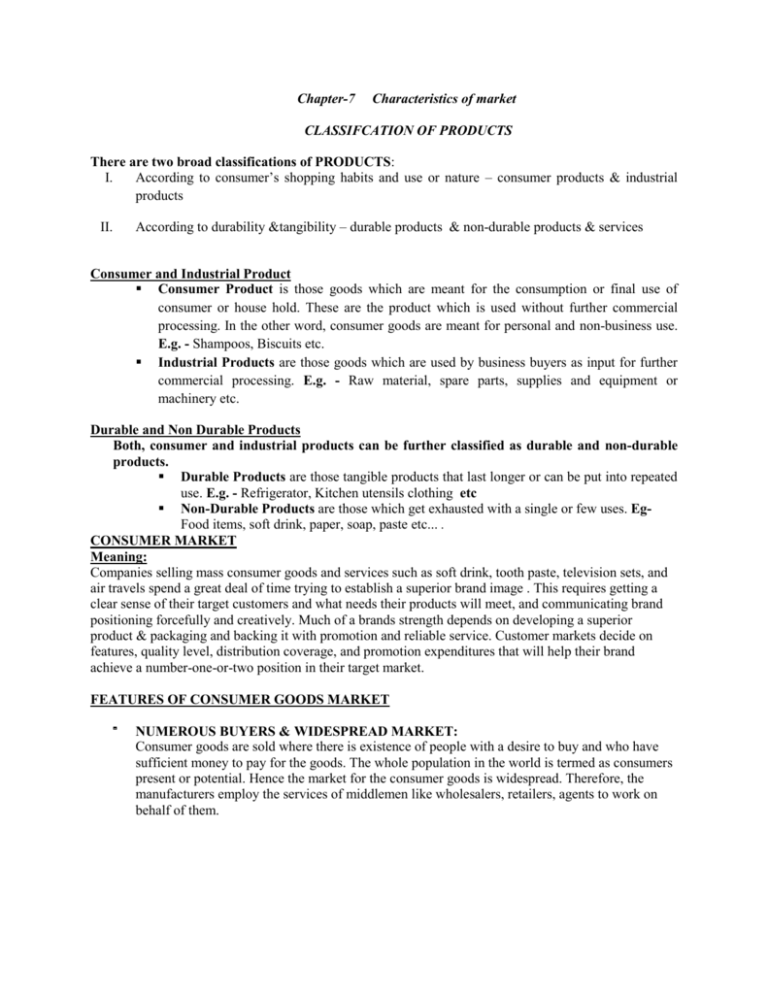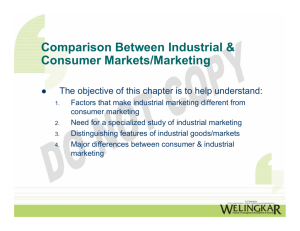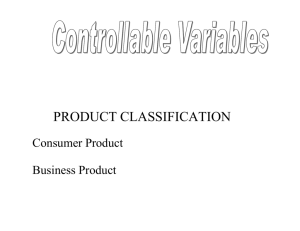File - the notes of comk class
advertisement

Chapter-7 Characteristics of market CLASSIFCATION OF PRODUCTS There are two broad classifications of PRODUCTS: I. According to consumer’s shopping habits and use or nature – consumer products & industrial products According to durability &tangibility – durable products & non-durable products & services II. Consumer and Industrial Product Consumer Product is those goods which are meant for the consumption or final use of consumer or house hold. These are the product which is used without further commercial processing. In the other word, consumer goods are meant for personal and non-business use. E.g. - Shampoos, Biscuits etc. Industrial Products are those goods which are used by business buyers as input for further commercial processing. E.g. - Raw material, spare parts, supplies and equipment or machinery etc. Durable and Non Durable Products Both, consumer and industrial products can be further classified as durable and non-durable products. Durable Products are those tangible products that last longer or can be put into repeated use. E.g. - Refrigerator, Kitchen utensils clothing etc Non-Durable Products are those which get exhausted with a single or few uses. EgFood items, soft drink, paper, soap, paste etc... . CONSUMER MARKET Meaning: Companies selling mass consumer goods and services such as soft drink, tooth paste, television sets, and air travels spend a great deal of time trying to establish a superior brand image . This requires getting a clear sense of their target customers and what needs their products will meet, and communicating brand positioning forcefully and creatively. Much of a brands strength depends on developing a superior product & packaging and backing it with promotion and reliable service. Customer markets decide on features, quality level, distribution coverage, and promotion expenditures that will help their brand achieve a number-one-or-two position in their target market. FEATURES OF CONSUMER GOODS MARKET NUMEROUS BUYERS & WIDESPREAD MARKET: Consumer goods are sold where there is existence of people with a desire to buy and who have sufficient money to pay for the goods. The whole population in the world is termed as consumers present or potential. Hence the market for the consumer goods is widespread. Therefore, the manufacturers employ the services of middlemen like wholesalers, retailers, agents to work on behalf of them. PURCHASE IN SMALL UNITS: Consumer goods are bought in small quantities and at frequent intervals. This is because(a) Majority of consumers are poor. (b) These goods are readily available at convenient points. (c) Unnecessary locking up of capital . (d) Risk of deterioration. POORLY INFORMED BUYERS: Consumers of these products are not fully aware of the details of goods sold in the market. They depend on the seller’s advice as he is a confused person. This is mainly because: (a) Variety of competitive products exists in the market. (b) The consumers have no time to study the market. (c) Sellers are adopting aggressive advertising. PERSONAL CONSDIERATION: Since consumers are buying for self-satisfaction or gratification, personal considerations & views dominate their decisions making as what to buy & where to buy. The considerations could be services of a seller, convenience of buying, income, standard of living, price, quality, etc. CHANNELS OF DISTRIBUTION: Consumer goods have a wide choice to distribute. They areManufacturer – Consumer Manufacturer – Retailer – Consumer Manufacturer – Wholesalers – Retailer – Consumer Manufacturer – Agents – Wholesalers – Consumer Manufacturer – Agent – Retailer – Consumer CONSUMER GOODS CLASSIFICATION CONSUMER GOODS CONVENIENCE GOODS STAPLES IMPULSE GOODS SHOPPING GOODS EMERGENCY GOODS HOMOGENOUS GOODS SPECIALITY GOODS HETEROGENOUS GOODS UNSOUGHT GOODS REGULARLY UNSOUGHT GOODS NEW UNSOUGHT GOODS 1.Convenience goods: These are those goods that are frequently, immediately and bought with minimum effort at short notice by the consumers. Example: toothpaste, grocery, Convenience goods can be further divided into: (a) Staples goods: These are those products that consumers purchase on regular basis. For e.g.: Ketchup, toothpastes, etc… (b) Impulse goods: These are those products that are purchase without any planning or research efforts. For e.g.: magazines, candy bars, ice creams etc. (c) Emergency goods: These are those goods that are purchased when a need is urgent. E.g.: umbrellas during a rainstorm, boots and shovels during the first winter snowstorm. 2.Shopping goods: They are those goods where consumers like to shop around to find the best features and price for the product. They devote considerable time in making selection of those before they buy. Shopping goods are bought only after the buyer compares the products of more than one store or looks at more than one assortment of goods before making a deliberate buying decision. Shopping goods can be further divided into: (a) Homogenous goods: These goods are similarly in quality but different enough in price to justify shopping comparisons. E.g. different models of Nokia phones or different t models of Toyota cars etc., (b) Heterogeneous goods: These goods differ in product features and services that may be more important than price. E.g clothing furniture etc., 3. Specialty goods: These products have unique characteristics and brand image identification for which a sufficient number of buyers is willing to make a special purchase effort. e.g. branded wrist watches such as Omega, Longinus etc., or cars like Lamborghini, Roll-Royce, Audi etc., 4.Unsought goods: These are those goods that the consumers do not know about or do not normally think of buying, like smoke detectors. 1)Regularly unsought goods:-existing products that consumers do not want now although they may eventually buy them. Eg-Life insurance, Lawyer’s service in preparing a will etc. ) New unsought goods:-Products that are totally new and unfamiliar. . Eg- Encyclopedia, Air Purifier, smoke detectors etc. Classification of Industrial Goods:a) Materials & Parts 1. Raw Materials- these are the basic commodities such as logs, ores, sand, sea, products such as fish, shrimps, oysters that are processed only as needed for safe, convenient and economical transport handling to reach the next processing stage or the place of end use. Raw material becomes part of final product losing original entity. 2. Manufactured/component materials and parts- these are the items that have already undergone processing to meet buyer specifications. Component parts are ready items to be assembled into a final product. The examples are car batteries, tyres, tubes, bulbs, small motor castings and the like. On other hand, component materials require further processing. Thus, paper, cement, glues, fibre may be needed in assembly. b) Capital Items 1. Installations- these are expensive capital items that do not become part of the final product but are expanded, depleted or worn-out during years of use. These include plants, buildings and other custom-made standard major equipment. These are immovable once installed. 2. Equipment’s- these comprise of tools and equipment’s or instruments and appliances that facilitate production of office activities such as lift-trucks, trolleys, drills, spanners, exhaust-fans, jacks, pincers, hammers, pliers, saws, type-writers and so on. Like installations, these are capital items that do not become part of the final product, but they are usually inexpensive and short-lived than the installations. Mostly these are movable. c) Supplies & Business Services- Supplies include items of repairs, maintenance and operation. These are less expensive items and are continually used up and these do not become part of the final product. These supplies may be factory supplies. Examples of factory supplies are greases, glues, belt- fasteners, paints, nails nuts and bolts, oils, cotton waste, wash room suppliers. Examples of office suppliers are papers, pens, clips, pencils, carbons, inks, refills, lubricating oils, tags, cleaners FEATURES OF INDUSTRIAL GOODS MARKET Industrial goods market consists of manufacture transport agencies; mining companies, public utilities, construction of the industries, banks, and insurance agencies etc. these factors distinguish the industrial market from market of manufactured goods. (a) GEOGRAPHICALLY CONCENTRATED – The units engaged in produced of similar products are not scattered widely over a geographical area. For e.g. Belgium, Kolhapur, Bangalore, Bombay units demand automobiles spare parts as the motor building units are located. (b) LIMITED BUYERS – The extent of the market is quite limited. This is because the industrial goods are durable and are purchased only when they wear out or because they are obsolete. Since the buyers are limited, the manufacturers have developed techniques for locating the buyers of particular industrial goods. The manufacturers have found direct marketing as the best suited channel for distribution of industrial goods. (c) LARGE INDUSTRIAL PURCHASE – The industrial orders although may be less in number, the value is very high. Thus, the seller of industrial goods must avoid poor salesmanship, on-competitive pricing, and uncertainty in delivery of products or indefinite products. (d) DERIVED DEMAND – The demand for industrial goods depends on the demand of other products and ultimately the demand of consumer goods. (e) TECHNICAL CONSIDERATIONS – since, industrial goods are brought and used in business operations, technical considerations is very important. Here, the buyer’s specific requirements are important. The products may be manufactured according the instructions and specifications of the users, this leads to development of special products or modifications of standard products in order to meet special needs. After sales service are also very important to industrial buyers. (f) RECIPROCAL BUYING – This is based on the principal – ‘if you buy from me, I will buy from you’. This is a very common process in the field of industrial marketing. For e.g., Ashok Leyland will buy tires and tubes from Ceat, if Ceat Company buys trucks from Leyland Company. A sort of barter and bilateral deal is inserted and encouraged this is done to have assured demand for their own products based on mutual understanding. (g) LEASING INSTEAD OF BUYING – A growing trend in industrial market is to lease out than to purchase outright basis. E.g. Transport agencies do not purchase courier but use on hire basis. There are 3 important reasons for leasing:-If the equipment offered represents a new discovery. -If the firm lacks adequate finances or it desires to use the working capital for other purposes. -If the need for installation is uncertain, the buyers do not want to purchase if it is found unsuitable they can wisely return it. (i) INFREQUENT PURCHASE – Since, industrial goods are durable; they are the means of production, they are purchased rarely. Big installations are purchased only once in many years. (h) CHANNEL OF DISTRIBUTION – The following channels are used to distribute industrial users Manufacturers – Industrial users Manufacturers – Wholesalers – Distributors Manufacturers – Agent – Industrial users Manufacturers – Agent – Wholesaler’s – Industrial use. Services : Definition of services had been “activities, benefits, or satisfactions, which are offered for sale, or provided n connection with the sale of goods.” Professor Philip Kotler defined services as “any activity or benefit that one party can offer to another that is essentially intangible and does not result in the ownership of anything.” Features of Service The features of services create challenges and opportunities to the service marketers. The features are: 1. INTANGIBILITY a physical product e.g. TV set, potatoes chips, facial cream are visible and concrete products. It is not possible to see full taste and smell services before they are bought. A service by nature is an abstract phenomenon it is not a physical object, it has mental connotations, while selling or promoting the sale of the sale of the service we have to concentrate entirely on the benefits and satisfaction a buyer can derive after that service. Banks promote the sale of credit cards by emphasizing the convenience and advantages derived from possessing a credit card. The burden of selling an intangible product like services falls mainly on the promotional mix 2. PERISHABILTY As the marketable commodity, a service has a high perishability. Time element assumes unique importance. If service is not used today, it is lost forever. It cannot be stored nor can it be carried forward. Un-utilized services are economic losses. For example: A building unoccupied, a person unemployed, credit not utilized, empty rooms in a 5 star hotel are examples representing perishable nature of service and business lost forever. 3. CHANGING DEMAND The market for services has wide fluctuations. The fluctuations in demand can be seasonal or weekly, daily or hourly. For example: during off-peak hours we need less transport. The use of public transport is less during the day time and more in the evening tourism is seasonal demand. Some service experts have come out with several strategies for bringing better match between the demand and supply of services. Part time employees during peak hours etc., 4. INSEPARABILITY personal service cannot be separated from the individual. Some services are created and supplied simultaneously, dentist, musician, dancer, and other professionals create and offer services at the same time. Direct sales of many service are the only channel of distribution. The market for offering personal services is bound to be limited. A person can sell his service only to limited customers in a day. However, when an institution is acting as a creator of a service we may have its representatives or agents to sell that service. Eg. A travel agent may represent and sell the services supplied by a tourist organization. 5. HETEROGENEITY The quality service offered by the competing firms cannot be standardized. Even the quality of the output of services sold by one seller cannot be uniform or standardized. For example, a technician cannot offer equal quantity of service when he is repairing a number of television sets. Similarly it is difficult to judge accurately the quality of services. Payment of price and the quality of the actual performance may not have an actual co relation. Price paid for service may be too high or too low in relation to actual performance. This is particularly significant in the case of entertainment and sport service. Classification of Services: From a practical point of view Services can be classified into Consumer services and Industrial Services Some important Consumer Services are: Catering and Entertainment services Hotels, motels, flotels and rotels Personal care services Medical and surgical services Household Services Educational Services Automobile services Transport services Communication services Insurance Services Financial Service Personal Security Services Some Important Industrial Services are: Financial Services Engineering Services Transport Services Warehousing services Insurance Services Advertising & Promotion Services Office services Management consultancy services Marketing Research services Manpower selection & training Middlemen services Communication services




